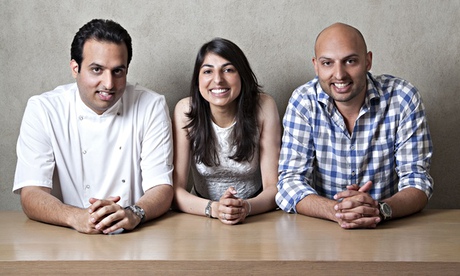Gymkhana: the best restaurant in Britain?
Gymkhana, a London restaurant based on the Anglo-Indian joints in Delhi and Mumbai, has been voted the best in Britain. Owner Karam Sethi explains how it took the city by storm
Gymkhana recipes: chicken butter masala, dorset brown crab with garlic and pepper, suckling pig vindaloo and flutterby lass

Eastern promise … Gymkhana’s Karam, Sunaina and Jyotin Sethi
Seven years ago, when his elder brother was named Young Venture Capitalist of the Year, chef Karam Sethi made a promise. “I told him that when I open a restaurant it will be named best in Britain,” he says. “We’ve always been competitive.” It took a while, but last week his prediction came true. Gymkhana, his uncompromising take on therestaurants of the Anglo-Indian sporting clubs of Delhi, Mumbai and beyond, was voted No 1 in the National Restaurant awards, Restaurant magazine’s annual countdown of the top 100 restaurants in the country. Not bad for a place that opened only nine months ago.
We take a seat in one of the basement snugs of the Mayfair space. So is it really the best restaurant in Britain? Sethi gives the thinnest of smiles. “No, of course not. Maybe the best restaurant that opened in 2013.” Don’t mistake this for modesty. He admits that when he heard they were on the list, he was certain they would make the top 30. “Outside of that, I would have been disappointed.” The confidence is all the more extraordinary for a man who is self-taught and who set out to break with the convention of the high-end Mayfair Indian.
It is not simply that the food is served family-style, or that the room, with its rattan furniture, dark wood booths and ceiling fans, is some way from the kitsch luxe of neighbours such as Benares and Tamarind. It is also the gutsy nature of that food, which draws on home rather than hotel traditions. Ever since 2001, when Zaika (now closed) and Tamarind won the first Michelin stars awarded to restaurants serving food from the Indian subcontinent, there has been a struggle between the down-and-dirty of Britain’s high-street curry house tradition and the smoothed-off edges of the luxury version, born in the five-star hotels of India.
The food at Gymkhana has bridged this gap. It is there in Sethi’s taste for game and offal. There is the biryani of wild muntjac deer, the seekh kebabs of quail and the deep, dark, duck curry, served with a crisp, feathery dosa and a little coconut chutney. Best of all there is the intense curry of minced kid goat, flavoured with nutty fenugreek, offered with jewels of goat brain. “It’s our biggest seller,” Sethi says, proudly. “The aim was always to provide something new. It’s a familiar menu with twists, hence the use of quail and venison. It’s very rustic stuff.”
Not that 30-year-old Sethi could describe himself as such. The middle-class son of a chartered accountant from Delhi, he grew up in Finchley, north London, and went to the fee-paying Haberdashers’ Aske’s school in Elstree, Hertfordshire, whose pupils do not generally take proper jobs in kitchens. (Full disclosure: I went to the same school.) But Sethi always knew what he wanted to do. “I learned to cook with my mum Meena; she was undoubtedly my biggest influence,” he says. “My parents always supported me.” When he was 15, while his fellow pupils took work experience in banks and lawyers’ offices, he flew to Stuttgart to work in a hotel kitchen; before university he spent a year in hotel kitchens in Delhi. “What can I tell you? I’ve always been a greedy bastard.”
After studying business management at university, he set himself up as a private caterer. A stint in the kitchens at the flash Knightsbridge Japanese restaurant Zuma was followed, at 23, by the opening of his first restaurant, Trishna in Marylebone. In 2008, its very precise take on Indian classics received a Michelin star. Owning his own restaurant had been the extent of his ambition, he admits. So has the sibling, Gymkhana, eclipsed the original? “No, Trishna will always be the mothership. That was where the reputation was built.”
Increasingly, Trishna is a mother to many children. A couple of years ago, Sethi’s older brother Jyotin left the City to join Karam in creating the Sethi Group. They backed James Knappett’s hot dog and champagne restaurant Bubbledogs, and his high-end restaurant the Kitchen Table, which made No 15 in the National Restaurant awards list, as well as chef James Lowe at Lyle’s, named “the one to watch”. They also have a restaurant in Copenhagen called Veranda. “The goal is to create a multicuisine group, partnering with excellent chefs and sommeliers,” Sethi says. “It’s entirely food-led. The chef has to have a strong identity. We have zero creative control. It’s all theirs.”
They have another five projects in development. Sethi has no doubt there is an appetite for it all in London. “When we opened Trishna, there was very low interest in what we were doing,” he says. “But everything’s changed … Restaurants are now London’s nightlife.”
Premises are in short supply and rents at a premium, which may partly explain the big price tag on a meal at Gymkhana. Sethi is at pains to point out that they do a set four courses for £25, and a beer and snacks for £15. But, he admits, the full experience – including quinine-sour cocktails from a list designed by his sommelier sister Sunaina – will cost £60-plus a head. There was some negative reaction to this, despite the fact that few people seem personally affronted by the notion of French or Italian food costing a lot.
It is as though the cheapness of the high-street curry house (generally poor-quality ingredients and low-standard batch cooking) has made anything of more ambition unacceptable. Sethi shrugs. “I think it’s because there’s no really cheap version of French or Italian as there is with Indian food,” he says. Not that he needs to worry. Business is booming. He’s fully booked. And being voted No 1 in the National Restaurant awards is hardly going to hurt.
Source: Theguadian



Comments